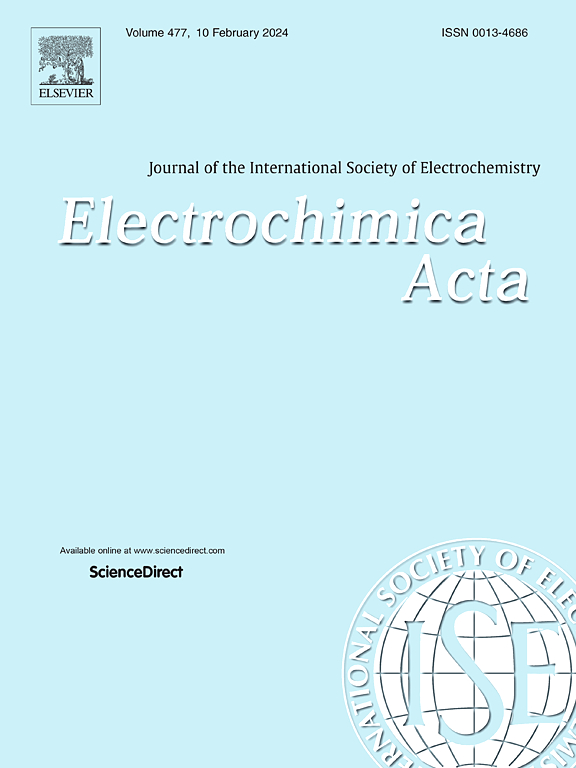Melamine-formaldehyde resin-derived carbon and graphene synergistically coated porous silicon for high-performance lithium-ion battery anodes
IF 5.5
3区 材料科学
Q1 ELECTROCHEMISTRY
引用次数: 0
Abstract
Silicon-based anode materials have garnered significant attention as a leading candidate for next-generation batteries, primarily attributed to their remarkable theoretical capacity (4200 mAh g-1), low operating potential (0.4 V vs Li/Li+), and naturally abundant resource characteristics. However, the practical implementation of silicon anodes encounters substantial obstacles stemming from insufficient electrical conductivity, severe volumetric expansion during charge/discharge cycles, and instability within the solid-electrolyte interphase (SEI) formation. To address these issues, this paper synthesizes melamine formaldehyde resin via a two-step liquid-phase method and encapsulates porous silicon with graphene in combination. After pyrolysis, a PSi@MFC/rGO composite anode material with nitrogen-doped carbon coating and graphene as the conductive matrix was synthesized, exhibiting excellent electrochemical performance. The 0.4PSi@MFC/rGO-0.009 composite anode material synthesized with moderate silicon content (0.4 g) and graphene loading (9 ‰) exhibited the optimal performance. The material displayed an initial discharge capacity of 2574.9 mAh g-1 within the first three charge-discharge cycles under an activation current density of 0.1 A g-1. Subsequently, it achieved a reversible capacity of 881.1 mAh g-1 after 200 cycles at 0.5 A g-1. Even following 400 continuous cycles at 1 A g-1, the composite retained a substantial reversible capacity of 625.3 mAh g-1 while preserving excellent cycling stability. This study presents a facile, cost-effective, and viable processing strategy for fabricating silicon anodes.

三聚氰胺甲醛树脂衍生碳和石墨烯协同涂覆多孔硅用于高性能锂离子电池阳极
硅基负极材料作为下一代电池的主要候选材料,由于其卓越的理论容量(4200 mAh g-1)、低工作电位(0.4 V vs Li/Li+)和天然丰富的资源特性而备受关注。然而,硅阳极的实际应用遇到了很大的障碍,这些障碍来自于导电性不足、充放电周期中严重的体积膨胀以及固体-电解质间相(SEI)形成过程中的不稳定性。为了解决这些问题,本文采用两步液相法合成了三聚氰胺甲醛树脂,并将多孔硅与石墨烯复合封装。热解后,合成了以氮掺杂碳涂层和石墨烯为导电基体的PSi@MFC/rGO复合负极材料,具有优异的电化学性能。硅含量适中(0.4 g)、石墨烯负载适中(9‰)的0.4PSi@MFC/rGO-0.009复合负极材料表现出最佳性能。在0.1 A g-1的激活电流密度下,该材料在前三次充放电循环中显示出2574.9 mAh g-1的初始放电容量。随后,在0.5 a g-1下循环200次后,它达到了881.1 mAh g-1的可逆容量。即使在1 A g-1下连续循环400次,该复合材料也保持了625.3 mAh g-1的大量可逆容量,同时保持了出色的循环稳定性。本研究提出了一种简便、经济、可行的硅阳极制造工艺策略。
本文章由计算机程序翻译,如有差异,请以英文原文为准。
求助全文
约1分钟内获得全文
求助全文
来源期刊

Electrochimica Acta
工程技术-电化学
CiteScore
11.30
自引率
6.10%
发文量
1634
审稿时长
41 days
期刊介绍:
Electrochimica Acta is an international journal. It is intended for the publication of both original work and reviews in the field of electrochemistry. Electrochemistry should be interpreted to mean any of the research fields covered by the Divisions of the International Society of Electrochemistry listed below, as well as emerging scientific domains covered by ISE New Topics Committee.
 求助内容:
求助内容: 应助结果提醒方式:
应助结果提醒方式:


